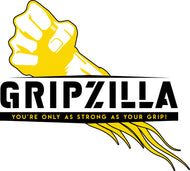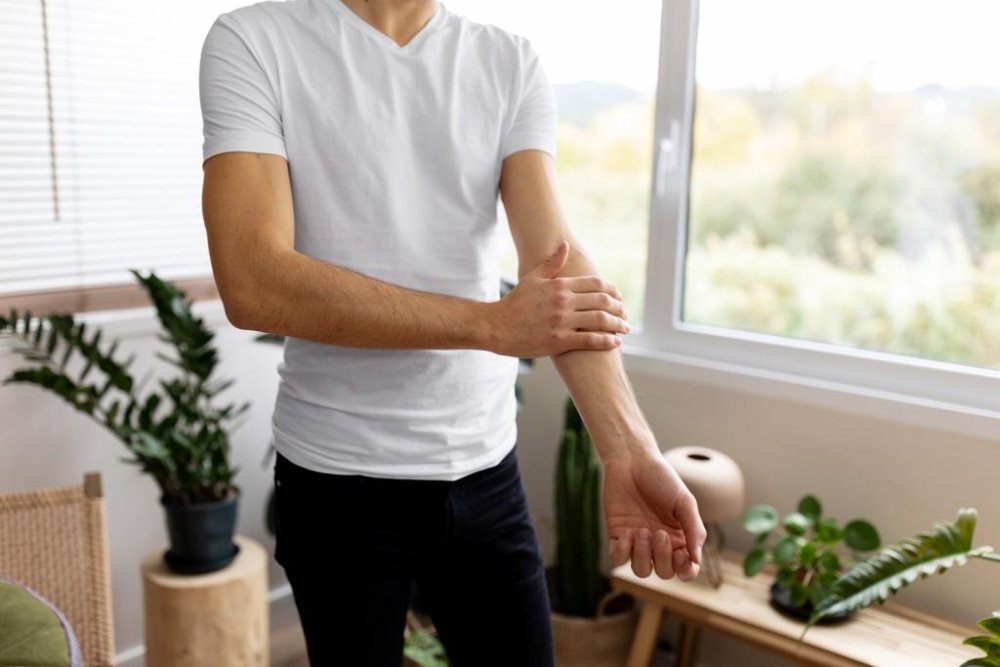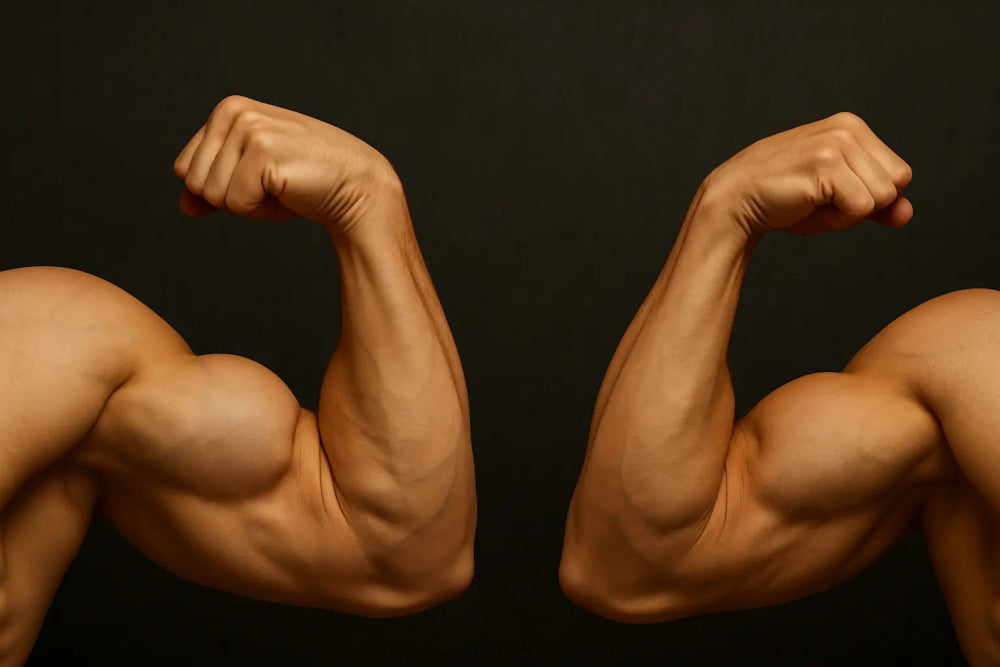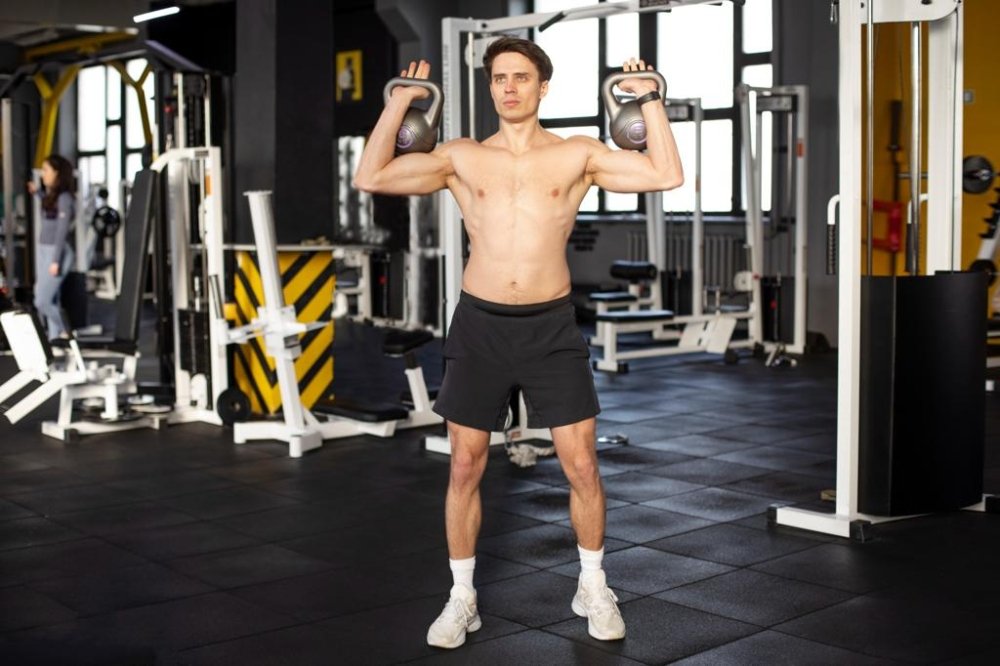Forearm pain while curling is a common issue among lifters and athletes performing bicep curls.
This type of pain can stem from improper mechanics, overuse, muscle imbalances, or grip deficiencies. Left unaddressed, it can lead to chronic strain or tendon injuries.
This article breaks down:
- The top causes of forearm pain during bicep curls
- Immediate and long-term fixes
- Best exercises to prevent and correct it
- Effective stretching and recovery methods
- When forearm pain signals a serious issue
10 Common Causes of Forearm Pain During Bicep Curls
1. Improper Wrist Position
Bending the wrists during curls shifts tension from the biceps to the forearm flexors and tendons, increasing strain.
2. Excessive Weight and Poor Tempo
Using weights beyond control leads to momentum-driven reps. The biceps disengage, and the forearm takes on excess tension.
3. Grip Strength Imbalance
When the grip is too weak to support the load, forearm muscles compensate, leading to overuse and pain.
4. Overactivation of the Brachioradialis
The brachioradialis becomes dominant when biceps are undertrained or poorly activated, resulting in forearm discomfort.
5. Tight Flexors or Extensors
Lack of flexibility in either group disrupts wrist positioning and joint alignment during curls.
6. No Warm-Up
Cold tendons and stiff muscles lack elasticity. Jumping into heavy curls without warm-up increases injury risk.
7. Overuse of Straight Bars
Straight bars limit wrist mobility and often lock the joint into an unnatural angle, amplifying forearm tension.
8. Neglecting Wrist Extensors
Training only wrist flexors without strengthening extensors leads to muscular imbalance and chronic forearm tightness.
9. Overtraining With Inadequate Recovery
High-frequency arm training without rest or mobility work causes inflammation, leading to persistent forearm pain from lifting.
10. Excessive Use of Lifting Straps
Using straps during curls bypasses grip activation, weakening the stabilizing muscles of the forearm over time.
How to Fix Forearm Pain When Curling
1. Neutral Grip Curls
Switch to hammer curls or use ropes and dumbbells to reduce joint stress and tendon tension.
2. EZ Curl Bars Instead of Straight Bars
EZ bars allow a semi-supinated grip, reducing stress on the forearm tendons and wrists.
3. Lower Weight and Improve Tempo
Use a controlled, slow eccentric (3–4 seconds on the negative). This reduces joint load and builds biceps safely.
4. Grip Strength Training
Add targeted grip work using tools like:
- Gripzilla Gripper Rings – for flexor endurance
- Gripzilla Dynamo – for finger control and strength
- Gripzilla Tornado – for dynamic wrist stability
5. Balance Training Volume
Avoid overloading your arms with too much volume in a short window. Space arm workouts 48–72 hours apart and monitor fatigue.
Best Exercises to Strengthen Forearms and Eliminate Curl Pain
1. Wrist Curls and Reverse Wrist Curls
These build strength in both wrist flexors and extensors, improving joint support.
2. Farmer’s Carries
Grip-intensive movement that activates forearm stabilizers under heavy load.
3. Plate Pinches
Static hold that targets finger strength and forearm endurance.
4. Dead Hangs
Stretches the forearms and builds raw grip strength through time-under-tension.
5. Gripzilla Protocols
- Use Gripper Rings for volume sets (15–20 reps)
- Add Tornado for wrist torque control (30–60 second rotations)
- Train with Dynamo for finger and tendon development
How to Stretch and Release Tight Forearms After Curling
1. Forearm Flexor Stretch
Extend the arm, palm up, fingers down. Apply light pressure to the fingertips.
2. Forearm Extensor Stretch
Extend the arm, palm down, fingers down. Pull fingers gently toward the body.
3. Lacrosse Ball Forearm Smash
Use a ball or massage tool to apply deep pressure to the muscle belly and tendons.
4. Contrast Baths
Alternate 2 minutes in cold water, 2 minutes in warm water. Repeat for 3–4 rounds to improve circulation and reduce inflammation.
5. Nerve Glides
Use median and radial nerve flossing drills to reduce nerve tension that can mimic muscular pain.
When Is Forearm Pain Serious? Signs to Stop Training
1. Burning, Tingling, or Numbness
Indicates possible nerve involvement. Stop training and assess further.
2. Pain During Basic Daily Movements
If pain occurs during light tasks (typing, brushing teeth), inflammation is high.
3. Swelling, Redness, or Heat
Could be early signs of tendonitis or a soft tissue injury.
4. Night Pain
If pain disrupts sleep or worsens at night, nerve irritation may be present.
5. No Improvement With Rest
Pain that persists after 5–7 days off training should be evaluated by a specialist.
Conclusion
Forearm pain during curls is typically a sign of poor mechanics, weak grip, muscular imbalance, or inadequate recovery.
With proper technique adjustments, targeted strengthening, and consistent mobility work, most cases can be corrected quickly.
To accelerate forearm recovery and build long-term stability, use:
- Gripzilla Gripper Rings for daily grip conditioning
- Gripzilla Tornado for wrist rotation control and endurance
- Gripzilla Dynamo for tendon health and finger strength
Building pain-free forearms means training smarter, not harder.



